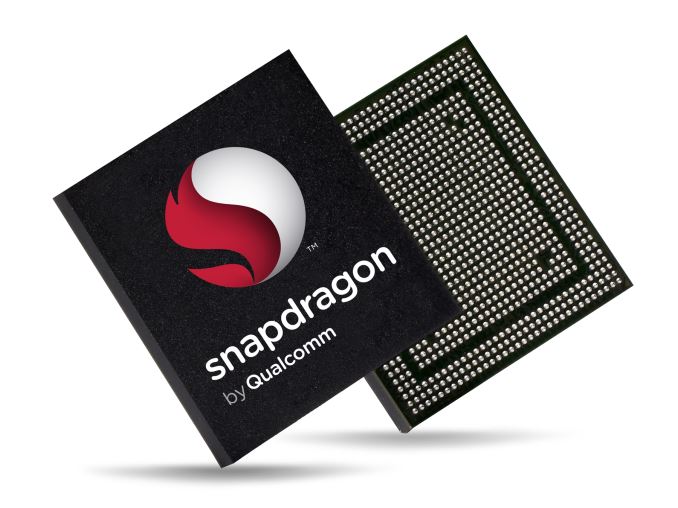Qualcomm Announces Snapdragon 821: 2.4 GHz Kryo
by Joshua Ho on July 11, 2016 7:30 AM EST
If you’ve been paying attention to the right places in the past few months it was probably obvious this was coming, but Qualcomm is announcing a higher tier to their Snapdragon 82x lineup, known as the Snapdragon 821 or MSM8996 Pro. While today’s announcement basically boils down to acknowledging that this SoC exists and that the big CPU cores have a clock speed of 2.4 GHz, it’s likely that in the months since the Snapdragon 820 was released Qualcomm engineering staff have been working on resolving various errata as well as improving their floorplanning and architecture implementation. It’s also likely that we will see a few new or otherwise revised IP blocks.
| Snapdragon 820 | Snapdragon 821 | |
| CPU Perf Cluster | 2x Kryo 2.2 GHz | 2x Kryo 2.4 GHz |
| CPU Power Cluster | 2x Kryo 1.6 GHz | 2x Kryo >2 GHz |
| GPU | Adreno 530 624 MHz | Adreno ??? ~650 MHz |
What isn’t in this announcement is that the power cluster will likely be above 2 GHz and GPU clocks look to be around 650 MHz but without knowing whether there are some changes other than clock relative to Adreno 530 we can’t really estimate the performance of this part. However, this information can be subject to change depending upon what happens at Qualcomm. It's important to note here that while these changes may seem to be small that improvements in the implementation of an SoC can have a dramatic effect on performance and power. I’m sure we’ll be learning more about this SoC in the coming months so for now we’ll just have to wait and see what comes next.










78 Comments
View All Comments
UltraWide - Monday, July 11, 2016 - link
LOL clickbaitAlexey291 - Monday, July 11, 2016 - link
Yup business as usual these days...colinisation - Monday, July 11, 2016 - link
Joshua / Andrei,Were there not rumours of another revision - Snapdragon 823? Or is that the Samsung manufactured variant.
Also what happened to the L3 Cache, heard any whispers of it being enabled or removed entirely?
Thanks
JoshHo - Monday, July 11, 2016 - link
L3 on the S820 was not shipped due to cost. Hard to say whether Snapdragon 821 will ship with an L3.jjj - Monday, July 11, 2016 - link
Lets see how it melts, hard to trust them at this point.BTW you guys keep promising a proper review for SD820, somehow you've managed to delay it until it was irrelevant.The most value is on day one, delaying it for months and months renders it pointless, you need to do better even if it means splitting it in many relevant bits.
kingmustard - Monday, July 11, 2016 - link
The 821 is a higher-clocked 820, that's all. Same GPU (Adreno 530), same DSP (Hexagon 680), same memory bandwidth etc.It's the 830 (with its Adreno 540) that I'm looking forward to getting into my devices.
Stochastic - Monday, July 11, 2016 - link
Any guesses as to when 821 and 830 SoCs will begin shipping in devices? I'm assuming we'll have to wait until 2017 for mainstream phones in the US.jjj - Monday, July 11, 2016 - link
Looks like the small cores might be at 1996MHz and 2188MHz https://browser.primatelabs.com/geekbench3/search?...https://browser.primatelabs.com/geekbench3/search?...
Assuming the 2 versions for SD821 that top at 2.2GHz and 2.4GHz.
Note the "variant 2" here "ARM implementer 81 architecture 8 variant 2 part 517 revision 0".
HideOut - Monday, July 11, 2016 - link
Well now we know what cpu the Note 7 will have this fall.versesuvius - Tuesday, July 12, 2016 - link
Intel and ARM are approaching the same point from two opposite directions. Intel is lowering the TDP and ARM increasing the TDP. And at that point Intel will be the winner. It could even be AMD. All Intel has to do is to remove some instructions from its x86 set and use the margin somewhere else or given the competition, nowhere at all. These ARM new revisions with no tangible improvement in performance are just aimed at keeping the prices at their current levels. That is all. The mobile market has peaked and the mobile devices can only improve on their communication speed and volume, which is dependent on a lot other than the chip in the mobile device.